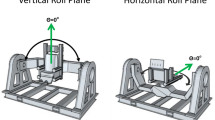Abstract
The head and balance exercise appear to be the most convenient and useful procedure in rehabilitating cases of positional vertigo.
Similar content being viewed by others
References
Agarwal, S. P.; Mishra, S. C; and Chhabra, D. K.; Evaluation of the positional tests in topographical diagnosis of peripheral and central vestibular dysfunctions, Thesis for M. S., Lucknow University, Lucknow (1979).
Aschan, G (1961), The pathogenesis of positional nystagmusActa Otolaryngologica; Supl.159: 90.
Aubry M; and Pialoux, P. (1957) Maladie de l’ Oreilla, Enterue et Oto neurologie, Paris, Masson.
Barany, R (1921) Diagnose von Krankheitserscheinungen in Bereiche des Otolithen apparates,Acta Otolaryngologica,2: 434.
Barber, H.O; (1964) Positional nystagmus, especially after head injury,Laryngoscope,74: 891.
Cawthorne T (1945) Vestibuler injury,Proceedings of Royal Society of Medicine,39: 270.
Dix M. R. and Hood J. D. (1970) Vestibular Habituation, its clinical significance and relationship to vestibular neuronitis, Vestibular functions on Earth and Space, Ed, Stahle J; Oxford, Pergamon, page 171.
Dix M. R. and Hallpike C. S. (1952) The pathology, symptomatology and diagnosis of certain common disorders of vestibular system.Proceedings of Royal Soceity of Medicine,45: 341.
Gacek R. R., (1974) Transection of Posterior ampullary nerve for the relief of Benign Paroxysmal postional vertigo.Annals of Otology, rhinology and laryngology,83: 596.
Henricksson, N. G.; Pfaltz, C. R.; Torok, N. and Rubin, W; (1972) A symposium of vestibular system, Sandoz Monograph, Basel, Sandoz Limitted, page 26.
Hinchcliffe R; and Harrison D. F. N. (1976), The Scientific foundation of Otolaryngology, London, Heinemann, page 391.
Jongkees L B. W. (1961) On positional nystagmus,Acta Otolaryngologica, Supl.159: 78.
Nylen, C. O. (1950) Positional nystamus, A review and future prospects,Journal of Laryngology and Otology,64: 295.
Pfaltz C. R. (1977) Vestibular Habituation and central compensation, Advances in Oto-Rhino-Laryngology, Vol 2, Basel, Karger.; page 136.
Riesco Mc-Clure, J. S. (1957) Es el Vertigo Aural de Origin Exclusivamente Periferico ?, Review de Otorhinolaryngologie,17: 42.
Salman S. D. (1969) Positional nystagmus critical review and personal experiences,Archives of Otolaryngology,90: 58.
Schuknecht H. F. and Davison R. C. (1956) Deafness and Vertigo from head injury,Archives of Otolaryngology,65: 513.
Spiegel E. A. and Scale N. P. (1942) Positional nystagmua in cerebeller lesions,Journal of neurophysiology,5: 247.
Author information
Authors and Affiliations
Rights and permissions
About this article
Cite this article
Mishra, S.C., Chhabra, D.K. & Agarwal, S.P. Habituation to positional vertigo. Indian J Otolaryngol 32, 61–64 (1980). https://doi.org/10.1007/BF03047585
Issue Date:
DOI: https://doi.org/10.1007/BF03047585




